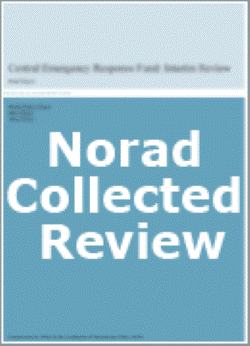Final Evaluation of SRV 0038- Rural Development in Coastal Areas of Trieu Phong District, Quang Tri Province
Om publikasjonen
- Utgitt: mars 2008
- Serie: Norad-innsamlede rapporter
- Type: --
- Utført av: PEM Consult, Copenhagen, Denmark
- Bestilt av: The Royal Norwegian Embassy, Hanoi, Vietnam
- Land: Vietnam
- Tema: Klima og miljø, Energi og infrastruktur, Primærnæring (landbruk fiske skogbruk)
- Antall sider: 64
- Serienummer: 31/2007
- ISBN: 978-82-7548-275-2
- ISSN: --
- Prosjektnummer: SRV-0038

The Project
The main objective of this multi-component integrated rural development project, implemented during 2000-2007, was to improve the living conditions of the poor, in seven coastal Communes of Trieu Phong District, in Central Vietnam. The project included reclamation and distribution of coastal land to poor households, who were also given financial and technical support for income generating aquaculture and animal husbandry activities. An additional component involved strengthening of road, electricity and school infrastructure in the project area.
The objective, design and implementation were in alignment with the priorities and the administrative structures and routines of the Vietnamese Government. The project budget of NOK 45 million was jointly funded, where Norwegian share was 80%, and the rest was covered by the Government of Vietnam.
Interesting Findings
- Alignment of project design and implementation with the priorities and routines of the partner government was a success factor. Assignment of the daily management of the project to a primarily locally staffed Project Management Unit contributed to local competence building and led to gradual reduction in International Technical Assistance to project management.
- Performance across all the project components was not uniform. The most relevant, effective and efficient were components that were adapted to the local context and conditions. For example, the aquaculture component in the project that was based on local traditional varieties of fish was most successful.
- The participatory approach involving villagers in land reclamation, construction of local primary schools using local labour and general emphasis on "help for self-help" focus in the project strengthened local ownership.
- Multi-sectoral rural infrastructure investments involving rural access roads, electricity distribution, and construction of primary schools combined with integrated agriculture and locally adapted aquaculture and animal husbandry led to significant increase in family incomes while at the same time assuring high survival rates for the project assets.
- However, introduction of high yielding varieties in aquaculture and capital intensive add-ons such as the shrimp hatchery in the project, were neither relevant nor successful. The commitment of large share of funds to construction activities, in the early phase of the project, reduced the possibilities for making adjustments and reallocations to more beneficial components during the course of the project.
Se nyhetssak om gjennomgangen
